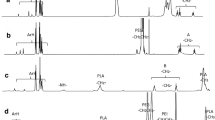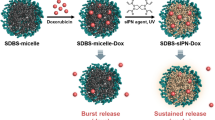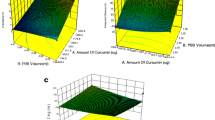Abstract
Multifunctional nanocarriers of two or more anticancer drugs with different pharmacological mechanisms are being developed for combination therapy, which aims at achieving synergistic effects in cancer treatment and overcoming the increasingly common problem of drug resistance. This contribution reports the fabrication of functional nanosized micellar carriers of doxorubicin (DOX) and caffeic acid phenethyl ester (CAPE) via coassembly of two well-defined amphiphilic ABA triblock copolymers comprising identical hydrophobic poly(ε-caprolactone) (PCL) blocks and different hydrophilic segments – poly(ethylene oxide) (PEO) or poly(acrylic acid) (PAA). CAPE was embedded into the PCL core via hydrophobic interactions, while DOX was loaded within a mixed PAA/PEO corona layer through complexation. The main physico-chemical properties of blank and dual drug-loaded micelles were investigated using dynamic and electrophoretic light scattering and transmission electron microscopy. Loading of CAPE and DOX increased the size and size distribution of carriers to some extent. However, the mixed micellar system was characterized by good colloidal stability and sustained release of the two drugs. The cytotoxic effect of DOX/CAPE-loaded mixed micelles in drug-resistant lymphoma cells expressing the multidrug resistance (MDR1) gene (L5178Y MDR1) was assessed.






Similar content being viewed by others
References
Li N, Zhao L, Qi L, Li Z, Luan Y. Polymer assembly: promising carriers as co-delivery systems for cancer therapy. Prog Polym Sci. 2016;58:1–26.
Teo PY, Cheng W, Hedrick JL, Yang YY. Co-delivery of drugs and plasmid DNA for cancer therapy. Adv Drug Deliv Rev. 2016;98:41–63.
Pan J, Rostamizadeh K, Filipczak N, Torchilin VP. Polymeric co-delivery systems in cancer treatment: an overview on component drugs’ dosage ratio effect. Molecules. 2019;24:1035.
Jhaveri A, Deshpande P, Torchilin V. Stimuli-sensitive nanopreparations for combination cancer therapy. J Control Release. 2014;190:352–70.
Riess G. Micellization of block copolymers. Prog Polym Sci. 2003;28:1107–70.
Duong HHP, Yung LYL. Synergistic co-delivery of doxorubicin and paclitaxel using multi-functional micelles for cancer treatment. Int J Pharm. 2013;454:486–95.
Abouzeid AH, Patel NR, Torchilin VP. Polyethylene glycol-phosphatidylethanolamine (PEG-PE)/vitamin E micelles for co-delivery of paclitaxel and curcumin to overcome multi-drug resistance in ovarian cancer. Int J Pharm. 2014;464:178–84.
Lee ALZ, Wang Y, Cheng HY, Pervaiz S, Yang YY. The co-delivery of paclitaxel and Herceptin using cationic micellar nanoparticles. Biomaterials. 2009;30:919–27.
Pan J, Attia SA, Subhan MA, Filipczak N, Mendes LP, Li X, et al. Monoclonal antibody 2C5-modified mixed dendrimer micelles for tumor-targeted codelivery of chemotherapeutics and siRNA. Mol Pharm. 2020;17:1638–47.
Akyol S, Ozturk G, Ginis Z, Armutcu F, Yigitoglu MR, Akyol O. In vivo and in vitro antineoplastic actions of caffeic acid phenethyl ester (CAPE): therapeutic perspectives. Nutr Cancer. 2013;65:515–26.
Derman S. Caffeic acid phenethyl ester loaded PLGA nanoparticles: effect of various process parameters on reaction yield, encapsulation efficiency, and particle size. J Nanomater. 2015;2015:341848.
Lee HY, Jeong YI, Kim EJ, Lee KD, Choi SH, Kim YJ, et al. Preparation of caffeic acid phenethyl ester-incorporated nanoparticles and their biological activity. J Pharm Sci. 2015;104:144–54.
Yoncheva K, Tzankova V, Yordanov Y, Tzankov B, Grancharov G, Aluani D, et al. Evaluation of antioxidant activity of caffeic acid phenethyl ester loaded block copolymer micelles. Biotechnol Biotechnol Equip. 2019;33:64–74.
Grancharov G, Atanasova M-D, Aluani D, Yoncheva K, Tzankova V, Trusheva B, et al. Functional block copolymers bearing pendant cinnamyl groups for enhanced solubilization of caffeic acid phenethyl ester. Polym J. 2020;52:435–47.
Carvalho C, Santos RX, Cardoso S, Correia S, Oliveira PJ, Santos MS, et al. Doxorubicin: the good, the bad and the ugly effect. Curr Med Chem. 2009;16:3267–85.
Fang XJ, Jiang H, Zhu YQ, Zhang LY, Fan QH, Tian Y. Doxorubicin induces drug resistance and expression of the novel CD44st via NF-κB in human breast cancer MCF-7 cells. Oncol Rep. 2014;31:2735–42.
Lovitt CJ, Shelper TB, Avery VM. Doxorubicin resistance in breast cancer cells is mediated by extracellular matrix proteins. BMC Cancer. 2018;18:41.
Christowitz C, Davis T, Isaacs A, van Niekerk G, Hattingh S, Engelbrecht AM. Mechanisms of doxorubicin-induced drug resistance and drug resistant tumour growth in a murine breast tumour model. BMC Cancer. 2019;19:757.
Kamenova K, Trzebicka B, Momekova D, Petrov P. Double stimuli responsive mixed aggregates from poly(acrylic acid)-block-poly(ε-caprolactone)-block-poly(acrylic acid) and poly(ethylene oxide)-block-poly(propylene oxide)-block-poly(ethylene oxide) triblock copolymers. Polym Bull. 2017;74:707–20.
Allen C, Maysinger D, Eisenberg A. Nano-engineering block copolymer aggregates for drug delivery. Colloids Surf B Biointerfaces. 1999;16:3–27.
Torchilin VP. PEG-based micelles as carriers of contrast agents for different imaging modalities. Adv Drug Deliv Rev. 2002;54:235–52.
Kamenova K, Haladjova E, Grancharov G, Kyulavska M, Tzankova V, Aluani D, et al. Co-assembly of block copolymers as a tool for developing novel micellar carriers of insulin for controlled drug delivery. Eur Polym J. 2018;104:1–9.
O’Brien J, Wilson I, Orton T, Pognan F. Investigation of the Alamar Blue (resazurin) fluorescent dye for the assessment of mammalian cell cytotoxicity. Eur J Biochem. 2000;267:5421–6.
Acknowledgements
This work was supported by the Bulgarian National Science Fund (Grant DN 09/1-2016). The authors are grateful to Professor V. Bankova for providing CAPE.
Author information
Authors and Affiliations
Corresponding author
Ethics declarations
Conflict of interest
The authors declare that they have no conflict of interest.
Additional information
Publisher’s note Springer Nature remains neutral with regard to jurisdictional claims in published maps and institutional affiliations.
Supplementary information
Rights and permissions
About this article
Cite this article
Kamenova, K., Grancharov, G., Tzankov, B. et al. Mixed micellar system for codelivery of doxorubicin and caffeic acid phenethyl ester: design and enhanced antitumor activity. Polym J 53, 471–479 (2021). https://doi.org/10.1038/s41428-020-00442-2
Received:
Revised:
Accepted:
Published:
Issue Date:
DOI: https://doi.org/10.1038/s41428-020-00442-2
- Springer Nature Limited




